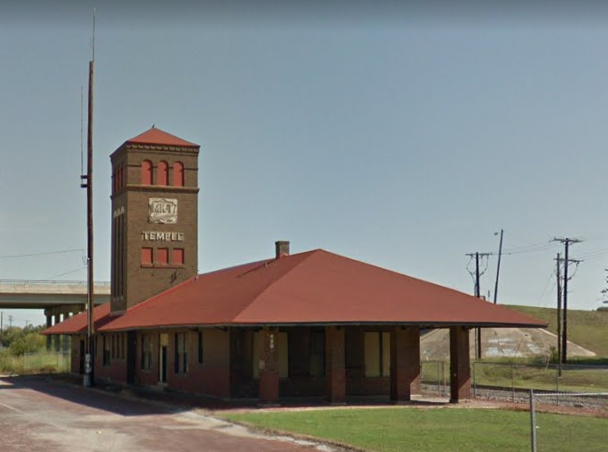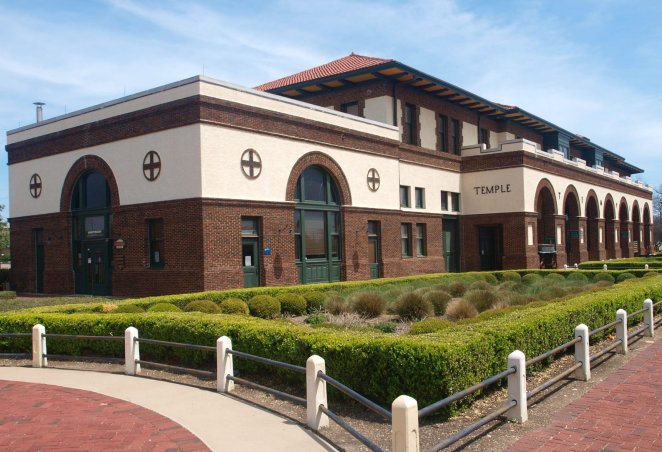Texas Railroad History - Tower 24 - Temple
A Crossing of the Gulf, Colorado & Santa Fe Railway and the
Missouri - Kansas - Texas Railroad
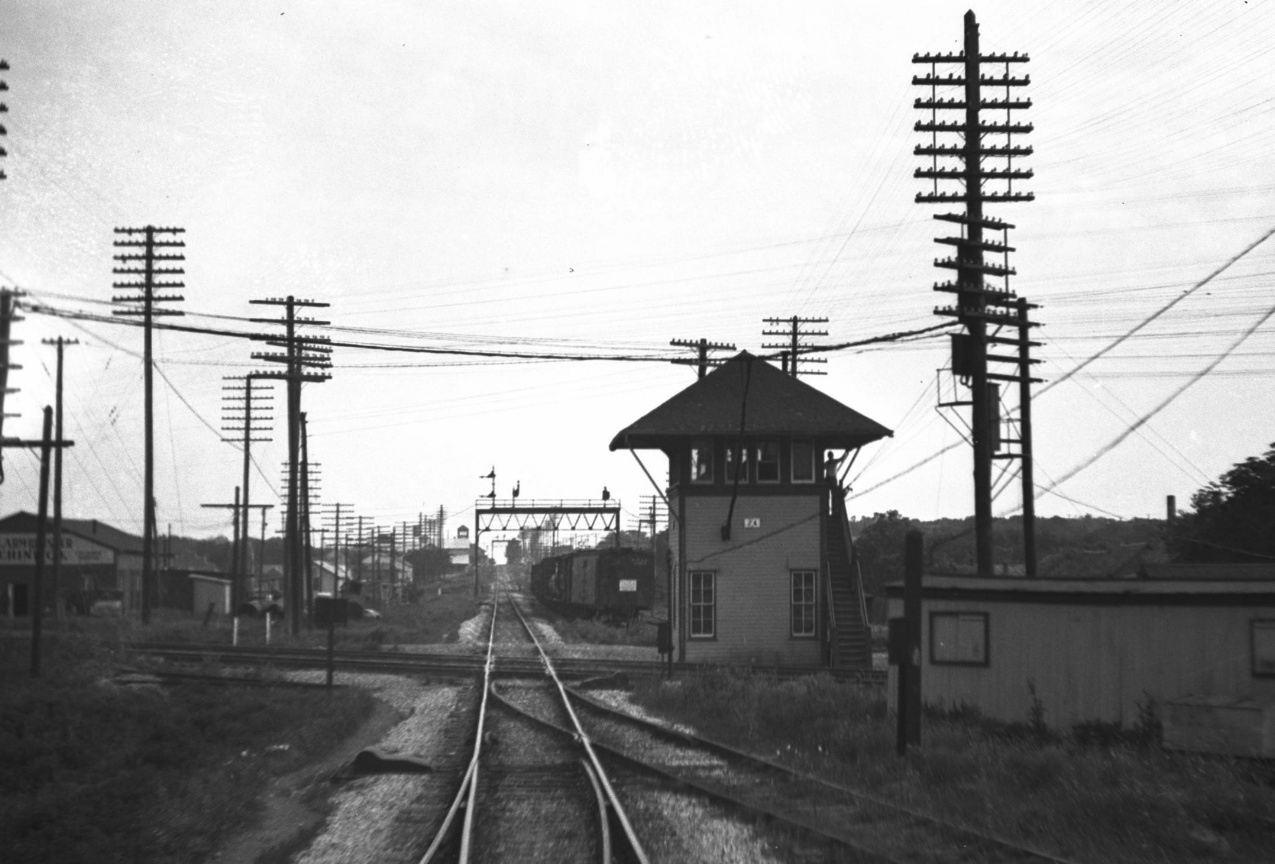
Above: The John W Barriger
III National Railroad Library supplies this image from a photo taken by Barriger
from the rear platform of his business car looking northeast along the Missouri - Kansas
- Texas (MKT) Railroad. Barriger was southbound toward MKT's major yard at Smithville, 89
miles distant, having just passed the MKT passenger station at Temple where his
train likely stopped. The tower atop the station is visible in the distance to
the left of the signal bridge. Tower 24 is in the foreground immediately east of the Gulf, Colorado & Santa Fe double track
crossing over the MKT line. This photo likely dates from the late 1930's or early 1940's.
Below Left: Tower 24
(courtesy Temple Railroad and Heritage Museum)
Below
Right: The Katy Engineering Dept. created a series of track charts
in 1915 for rail junctions across Texas. The Temple chart shows the Tower 24 crossing
(unmarked) along the right side of the image. (Ed
Chambers collection)

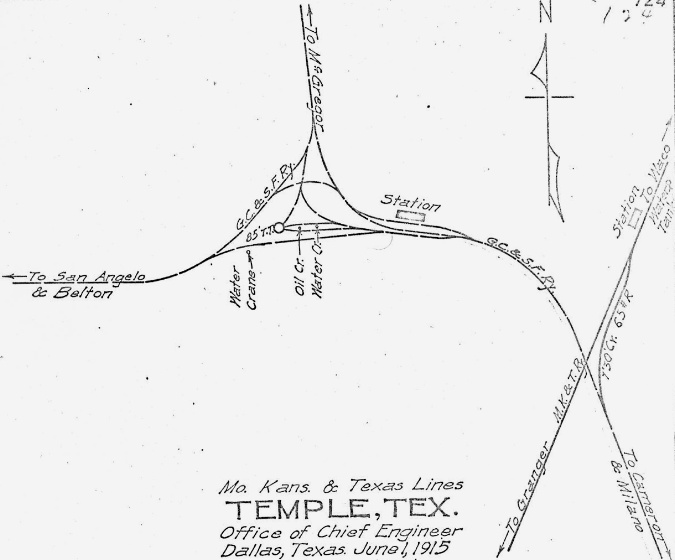
The Gulf, Colorado & Santa Fe (GC&SF) Railway was
established in Galveston in 1873 to provide a second railroad onto Galveston
Island, one that did not pass through Houston as the first one did, the
Galveston, Houston & Henderson (GH&H) Railroad. For a variety of reasons
(including Houston health officials occasionally declaring a "yellow fever
quarantine" against Galveston Island), freight bound for Galveston on the GH&H
did not always reach Galveston, sometimes being off-loaded in Houston or
Harrisburg along Buffalo Bayou. To be fair,
Houston leaders were attempting to turn Buffalo Bayou into an ocean-navigable
channel to the Gulf of Mexico in part to overcome restrictive policies practiced
by the Galveston Wharf Company that were detrimental to Houston's interests.
Galveston's desire to have a railroad onto the island that bypassed Houston led
to the founding of the GC&SF. Starting out from Galveston with a new
bridge over Galveston Bay,
the GC&SF's construction stayed well south of Houston, reaching
Arcola in 1877 and Richmond
in 1879. The railroad then went through a foreclosure and was purchased by
its Treasurer, George Sealy, who reorganized the company under its original
charter. Construction resumed in 1880 at Rosenberg and
turned northwest to
Brenham.
In 1881, the GC&SF made substantial geographic advances by building 100 miles from Brenham to Belton and 128 miles
from Temple to Ft. Worth. Temple began as a construction camp
known as Temple Junction, named for the
railroad's chief engineer, Bernard Temple ("Junction" was dropped when the Post
Office opened.) The tracks to Belton passed through
Temple and it became the branch point for the line north to Ft. Worth. As the
tracks were being extended westward beyond Belton to Lampasas (1882) and Brownwood (1885), Temple
was morphing into a significant town at the center of the GC&SF's network. From Temple,
lengthy tracks to Galveston, Ft. Worth and Brownwood radiated out in different directions.
About the time the GC&SF construction crews were first reaching Temple Junction,
railroad magnate Jay Gould was deciding how best to extend one of his
properties, the Missouri - Kansas - Texas (MKT, "Katy") Railroad, farther south. The Katy had crossed the Red River into
Denison in 1873 and had
reached Ft. Worth in 1880 using rights from
Whitesboro on a rail line it shared with the Texas & Pacific (T&P), another
Gould railroad. In 1881, the Katy built south from Ft. Worth
through Hillsboro and Waco, reaching
Taylor in 1882. About 35
miles north of Taylor, the Katy's tracks crossed the GC&SF at grade on the
east side of Temple roughly a mile southeast of where the GC&SF's three lines
converged. Gould then lost control of the Katy during its receivership
in 1888. The Katy subsequently emerged from bankruptcy as an independent
railroad, and it remained that way for one hundred years.
The GC&SF continued incorporating branch lines into its network, mostly by construction
but also by acquisition. By 1883 it had added the important
towns of Dallas and Houston to its network. Despite operational success, the
GC&SF had an obvious problem: it was entirely dependent on local traffic.
Two of Gould's railroads in Texas, the T&P and the International & Great
Northern (I-GN), were working with his Missouri Pacific (MP) system through
Texarkana to exchange traffic between Texas and the upper midwest
via Memphis and St. Louis. The I-GN also had service to
Laredo for markets in Mexico. Additionally, the Katy railroad under Gould had
established a cooperative relationship with the Houston & Texas Central
(H&TC) through their common Denison gateway to interchange midwest traffic. Working with the Galveston,
Harrisburg & San Antonio (GH&SA) Railway, Southern Pacific (SP) had completed
its southern transcontinental line in 1883 and then leased the GH&SA. SP had
also acquired control of the H&TC in 1883, and it had acquired a line between
Houston and New Orleans when it purchased the Texas & New Orleans (T&NO) Railroad in
1881. The bottom line -- the GC&SF was destined to become a second class
railroad unless it found a partner that could stimulate
traffic in out-of-state markets.
The GC&SF's obvious suitor was the
much larger Atchison, Topeka & Santa Fe (AT&SF) Railway. The AT&SF was
completing its line across the western U.S. between Kansas and southern
California and wanted to expand into Texas, viewing Galveston as an attractive
port for midwest agriculture exports. The GC&SF's main line from Ft. Worth to Galveston
would serve AT&SF's plan if the two railroads found an appropriate interchange
point. Negotiations
between the two companies resulted in an 1886 agreement under which the AT&SF
would acquire the GC&SF on favorable terms if the GC&SF completed three
construction projects within a year, specifically, Ft. Worth to
Purcell, Indian Territory (where it would meet an AT&SF line building south); Dallas to
Paris (where it would meet the St. Louis San
Francisco Railway building
south); and Cleburne to Weatherford (where a
connection with the T&P would establish a shortcut to west Texas, bypassing Ft.
Worth.) The GC&SF was able to lay 300 miles of track in one year to
complete all of these projects, a substantial amount by any measure. The
acquisition proceeded as planned in 1887 and the GC&SF began operating as a
wholly-owned subsidiary of the AT&SF.
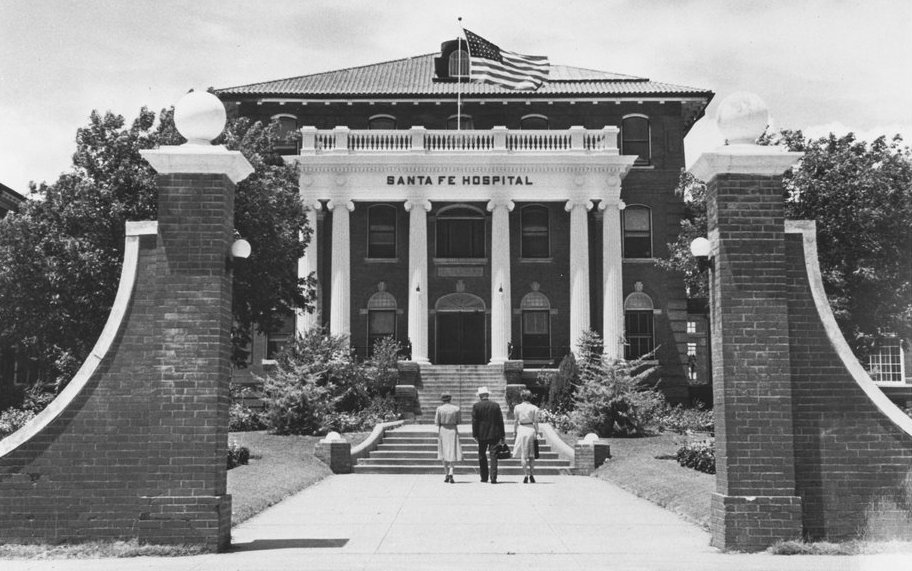 |
Temple was the center of GC&SF operations,
so in 1891, the company established the Santa Fe Hospital
there. Company hospitals were common in the industry; workers toiled
amidst various dangers everyday. Santa Fe employees enjoyed a prepaid hospitalization
benefit, one of the first railroads to offer this innovation. No one knew it at
the time, but a significant event affecting health care delivery in
Texas over the next century was the hiring of Dr. Arthur Scott to run
the Hospital in 1892.
Santa Fe Hospital only served railroad
employees, a policy that Dr. Scott lamented. In 1897, he formed a
private medical partnership with Dr. Raleigh White, Jr., one of his
staff physicians. They agreed to be paid to manage and staff the
Hospital for the railroad while also offering health care to all
citizens of Temple through a private clinic. In 1904, the partnership
opened a new hospital, ultimately called Scott & White Hospital, while
continuing to manage and staff the Santa Fe Hospital. Scott & White
expanded beyond Temple to provide health care across central Texas.
In 1966, the Santa Fe Hospital
began to accept non-employee patients and in 1983, it merged with the
Scott & White Hospital system. In 2013, the Scott & White
health care network combined with the Baylor Health Care System to form Baylor, Scott & White,
the largest not-for-profit health care system in Texas. (Kansas Historical
Society photo) |
In 1901, the
Texas Legislature passed a law assigning the Railroad Commission of Texas (RCT)
the responsibility for regulating interlockers at grade crossings of two
railroads. Interlockers allowed trains to rely on signals to determine whether
they needed to stop when crossing another line at grade. This
saved time and energy compared to uncontrolled crossings where all trains
were required to stop before proceeding. Railroads began submitting interlocker
plans to RCT for approval, each requiring final inspection by RCT before
becoming operational. RCT commissioned the interlockers at
Milano (Tower 23) and Temple (Tower 24) for
operation on the same
day, September 1, 1903. Considering that Santa Fe was the only railroad common to both of
these interlockers (only 43 miles apart) and the fact that the towers visually
appear to be the same design (and they each housed an electrical interlocking
plant manufactured by the Taylor Signal Co.) suggests that they were engineered and
constructed simultaneously by Santa Fe. This made sense as a cost-saving
measure, and since both crossings existed prior to 1901, the law required the
capital expense for the towers to be shared. The recurring costs of operating
and maintaining the towers were also shared by the railroads involved with each
interlocker.
The Tower 24 plant had 30
functions spread over 22 working levers, a significant level of functionality
implying the presence of numerous spur and exchange tracks nearby. Of the 23
interlockers that preceded Tower 24, only the interlockers at
East Waco, Chaney Junction
and Sherman were larger at the time. Statistics
published by RCT in 1906 showed an average of 74 movements per day past Tower 24. Beginning with RCT's 1917 Annual Report, the published table of active
interlockers states that the first railroad listed as a participant at an
interlocker is the one responsible for operating it. All RCT Annual Reports from
1917 through 1931 list the GC&SF first for Tower 24, indicating that it was the
railroad responsible for tower operations staffing. The 1931 RCT Annual Report,
the last to include the table of active interlockers, showed that Tower 24's
interlocking plant had grown to 48 functions.
Unlike many
railroad grade crossings in Texas, the Tower 24 site appears to have experienced no
changes to its main lines (other than perhaps double tracking the Santa Fe past
the tower.) Santa Fe merged with Burlington Northern to become Burlington
Northern Santa Fe (BNSF) in 1995. The track through the Tower 24 crossing
remains part of BNSF's busy main line to Galveston. One hundred years after the
Katy went into receivership and became an independent railroad, it was merged
into MP in 1988. MP had been acquired by Union Pacific (UP) in 1982, but was
continuing to use the Missouri Pacific name. Since 1997, the line through the
Tower 24 crossing has been operated under the UP name and continues to be used
as a major north/south route. The Tower 24 interlocker was long ago converted to
an automated system and the tower structure removed. The
removal date, and whether the tower was razed or relocated, has not been determined.
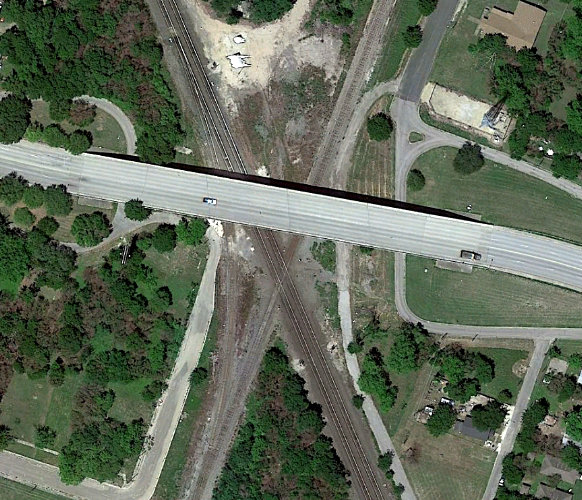
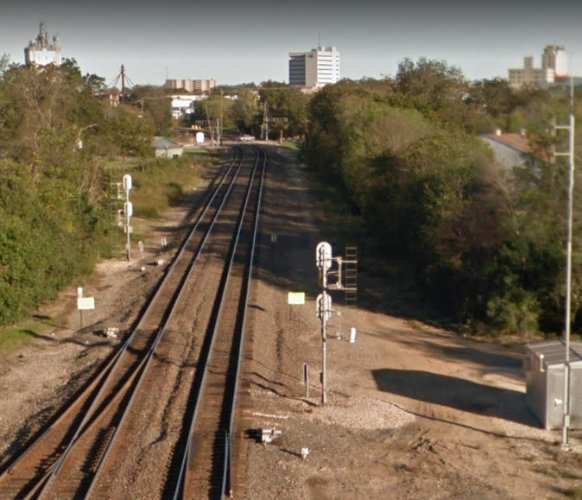
Above Left: The Tower 24 crossing is an X-pattern located southeast
of downtown Temple. The BNSF tracks cross on a NW/SE alignment while the UP tracks are on a NE/SW
alignment. A single connecting track remains in place west of the diamond. Note
that this differs from the 1915 Katy track chart where the only connecting track
shown was east of the crossing.
(Google Earth, May 2021) Above Right:
This 2018 Google Street View is looking northwest along the BNSF double track
from the East Ave. H bridge that passes almost directly over the Tower 24
crossing diamond.
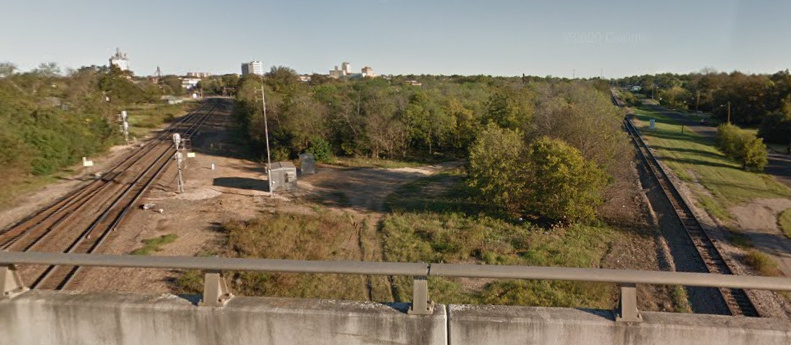
Above: This broader view from the East Ave. H bridge
looks north showing both the BNSF tracks (left) and the UP tracks (right). Although the tracks look almost parallel, they cross just south of the bridge,
behind (and below!) the camera.
Below: Looking east from S. 12th Street with the
connecting track in the foreground, the tail end of a southbound UP train is
just clearing the double diamond crossing at Tower 24, having passed beneath the
East Ave. H bridge moments earlier. (both images, Google Street View 2018)
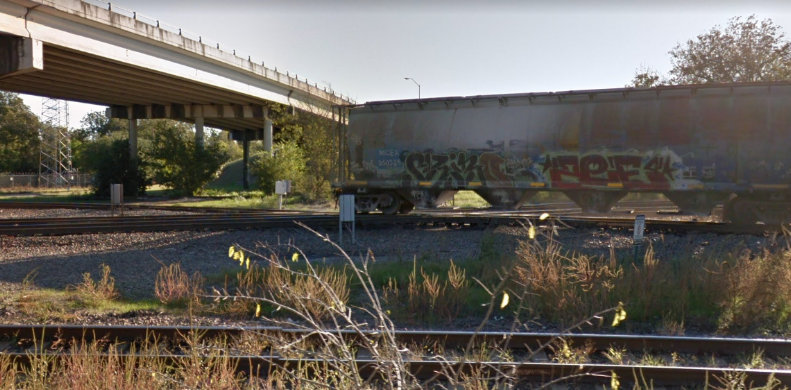
Like the main
lines past Tower 24, the passenger stations that served them have also remained
intact.
Below Left: The Katy depot in Temple (Google Street View, Oct,
2017) has survived to the present, abandoned. It was
sold by the City to a restaurant developer for $1 in early 2025, part of a
redevelopment effort the City is pursuing. Below Right: the Santa
Fe depot (courtesy Temple Railroad and Heritage Museum which is located in the
station)
